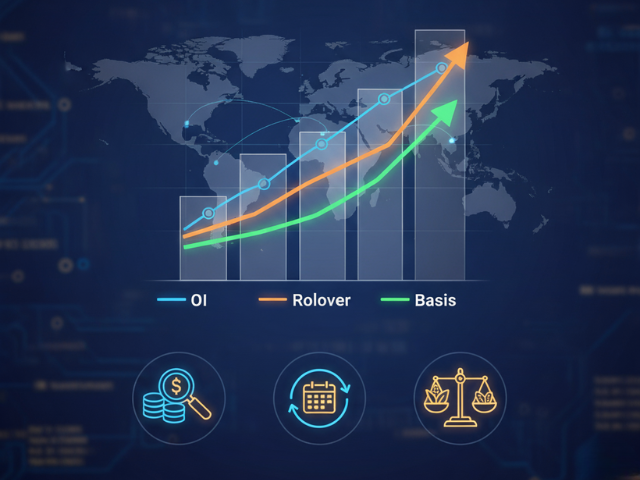


कमोडिटी फ्यूचर्स एक ऐसा डेरिवेटिव कॉन्ट्रैक्ट होता है, जिसमें आप किसी कमोडिटी (जैसे गोल्ड, क्रूड ऑयल, सिल्वर, या कॉपर) को भविष्य की तारीख पर तय कीमत पर खरीदने या बेचने का समझौता करते हैं।
उदाहरण के तौर पर —
अगर आप मानते हैं कि क्रूड ऑयल की कीमत बढ़ेगी, तो आप उसका फ्यूचर कॉन्ट्रैक्ट खरीदते हैं।
अगर कीमत बढ़ती है, तो आपको मुनाफा होता है; अगर गिरती है, तो नुकसान।
कमोडिटी ट्रेडिंग में सिर्फ कीमतें देखना पर्याप्त नहीं है।
डेटा एनालिसिस (OI, Volume, Rollover) से आप यह समझ सकते हैं कि —
इसलिए एक समझदार ट्रेडर के लिए फ्यूचर्स डेटा पढ़ना उतना ही ज़रूरी है जितना चार्ट देखना।
Open Interest (OI) बताता है कि किसी खास कमोडिटी फ्यूचर में कितने ओपन कॉन्ट्रैक्ट्स अभी तक क्लोज़ नहीं हुए हैं।
यह ट्रेंड की मजबूती और भागीदारी को दर्शाता है।
हर फ्यूचर कॉन्ट्रैक्ट की एक एक्सपायरी डेट होती है (आमतौर पर महीने के आखिरी सप्ताह में)।
अगर ट्रेडर अपनी पोजीशन को अगले महीने के कॉन्ट्रैक्ट में शिफ्ट करता है, तो इसे Rollover कहा जाता है।
उदाहरण:
अगर सिल्वर में 85% Rollover दिख रहा है, तो इसका मतलब है कि ज़्यादातर ट्रेडर्स ने अपनी लंबी पोजीशन को अगले महीने तक बढ़ा लिया है — यानी सकारात्मक सेंटिमेंट जारी है।
ट्रेडिंग में सही निर्णय लेने के लिए आपको तीनों डेटा को एक साथ पढ़ना चाहिए।स्मार्ट ट्रेडिंग टिप:
सिर्फ प्राइस देखकर ट्रेड न करें — OI और Volume की पुष्टि ज़रूर करें।
अधिकांश ब्रोकर्स जैसे Swastika Investmart अपने ग्राहकों को Futures Analytics Tools प्रदान करते हैं।
इनसे आप रियल-टाइम OI, Rollover और Volume डेटा देख सकते हैं।
Swastika Investmart के प्लेटफॉर्म पर:
👉 यहाँ क्लिक करें और डेटा देखें
भारत का कमोडिटी डेरिवेटिव मार्केट (MCX, NCDEX) विश्व के सबसे तेज़ी से बढ़ते बाजारों में से एक है।
यहाँ गोल्ड, सिल्वर, क्रूड, कॉपर, और एग्री-कमोडिटीज़ में रोज़ाना अरबों रुपये का कारोबार होता है।
सरकार और SEBI के सख्त नियामक ढाँचे के कारण यह मार्केट अब पहले से कहीं ज़्यादा पारदर्शी और निवेशक-अनुकूल बन गया है।
Swastika Investmart एक SEBI-registered broker है, जो कमोडिटी, इक्विटी और डेरिवेटिव ट्रेडिंग में
अपने रिसर्च-बेस्ड एनालिटिक्स टूल्स और ग्राहक समर्थन के लिए प्रसिद्ध है।
Swastika के साथ आपको मिलता है:
👉 अभी खाता खोलें और डेटा-ड्रिवन ट्रेडिंग शुरू करें।
1️⃣ OI क्या दर्शाता है?
OI दिखाता है कि मार्केट में कितने ओपन कॉन्ट्रैक्ट्स हैं — यह भागीदारी और ट्रेंड की मजबूती बताता है।
2️⃣ Rollover कैसे समझें?
अगर ज़्यादातर ट्रेडर्स अपनी पोजीशन अगले महीने ले जा रहे हैं, तो Rollover हाई होता है — इसका मतलब है कि ट्रेंड में विश्वास बना हुआ है।
3️⃣ क्या OI डेटा रोज़ बदलता है?
हाँ, हर दिन जब भी नए कॉन्ट्रैक्ट्स जुड़ते या खत्म होते हैं, OI डेटा अपडेट होता है।
4️⃣ Futures Trading में यह डेटा क्यों ज़रूरी है?
क्योंकि यह बताता है कि “पैसा कहाँ जा रहा है” — यानी स्मार्ट मनी किस दिशा में ट्रेड कर रही है।
5️⃣ क्या मैं Swastika पर यह डेटा लाइव देख सकता हूँ?
हाँ, Swastika के डैशबोर्ड में रियल-टाइम OI, Volume और Rollover डेटा उपलब्ध है।
कमोडिटी फ्यूचर्स डेटा को समझना हर निवेशक और ट्रेडर के लिए एक महत्वपूर्ण स्किल है।
OI और Rollover से आप सिर्फ ट्रेंड नहीं, बल्कि मार्केट की गहराई और मूड समझ सकते हैं।
अगर आप डेटा-आधारित ट्रेडिंग सीखना चाहते हैं और बेहतर निर्णय लेना चाहते हैं — Swastika Investmart के साथ जुड़ें


Trust Our Expert Picks
for Your Investments!



